Transtek Medical Electronics TMB1580-B Blood Pressure Monitor User Manual 13 Proposed Labeling
Guangdong Transtek Medical Electronics Co.,Ltd Blood Pressure Monitor 13 Proposed Labeling
User manual
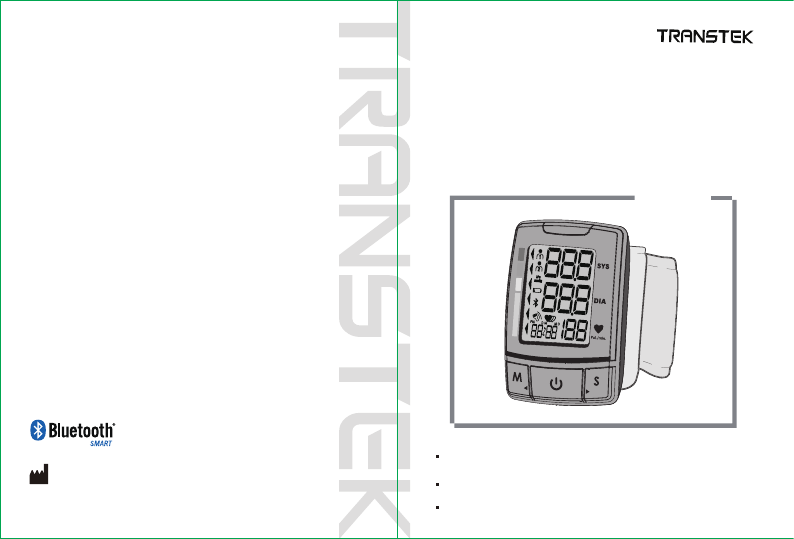
User Manual
Blood Pressure Monitor TMB-1580-BT
To use the monitor correctly and safely, please read the manual
thoroughly.
Thank you very much for selecting TRANSTEK Blood Pressure
Monitor TMB-1580-BT.
Please keep this manual well in order to reference in future.
Wrist Type
Version:1.0
Guangdong Transtek Medical Electronics Co., Ltd.
Zone A, No.105 ,Dongli Road, Torch Development District,
Zhongshan,528437,Guangdong,China

INTRODUCTION
...............................................................
2
Safety Information
LCD Display Signal
Monitor Components
BEFORE YOU START
..........................................................
5
Installing and Replacing the Batteries
Setting Date, Time and Measurement Unit
MEASUREMENT
...............................................................
12
Tie the Cuff
Pair-up the Blood Pressure Monitor with Your Device
Start the Measurement
Select the User ID
DATA MANAGEMENT 16
Recall the Records
Delete the Records
INFORMATION FOR USER
.....................................................
18
Tips for Measurement
Maintenance
ABOUT BLOOD PRESSURE
....................................................
20
What are systolic pressure and diastolic pressure?
What is the standard blood pressure classification?
Why does my blood pressure fluctuate throughout the day?
Why do I get a different blood pressure at home compared to the hospital?
Is the result the same if measuring on the right wrist?
TROUBLESHOOTING
.........................................................
22
SPECIFICATIONS
.............................................................
.............................................................
23
CONTACT INFORMATION
......................................................
24
24
COMPLIED STANDARDS LIST
FCC STATEMENT
.....................................................................
26
EMC GUIDANCE
......................................................
27
..........................................................
General Description
Indications for Use
1
CATALOGUE CATALOGUE
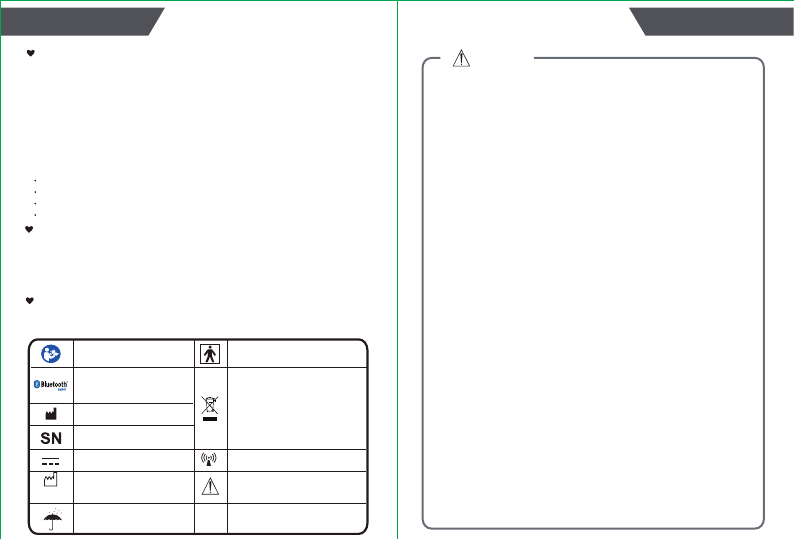
The signs below might be in the user manual, labeling or other component.
They are the requirement of standard and using.
Safety Information
Features:
Systolic blood pressure
Diastolic blood pressure
Pulse rate
60 records per each user
Symbol for “THE OPERATION
GUIDE MUST BE READ”
Symbol for “MANUFACTURER”
Symbol for “SERIAL NUMBER”
Symbol for “TYPE BF APPLIED
PARTS”
Symbol for “DIRECT CURRENT”
Symbol for “ENVIRONMENT
PROTECTION - Electrical waste
products should not be disposed of
with household waste. Please
recycle where facilities exist. Check
with your local authority or retailer for
recycling advice”
Symbol for “MANUFACTURE
DATE”
General Description
Thank you for selecting TRANSTEK Blood Pressure Monitor (TMB-1580-BT).
The monitor features blood pressure measurement, pulse rate measurement and
the result storage. The design provides you with two years of reliable service.
Readings taken by the TMB-1580-BT are equivalent to those obtained by a trained
observer using the cuff and stethoscope auscultation method.
This manual contains important safety and care information, and provides
step by step instructions for using the product.
Read the manual thoroughly before using the product.
The Bluetooth Combination Mark
Symbol for “Including RF
transmitter”
Indications for Use
The Transtek Blood Pressure Monitor is digital monitors intended for use in
measuring blood pressure and heartbeat rate with wrist circumference ranging
from 13.5 cm to 21.5 cm ( about 5⅓˝-8½˝ ).
It is intended for adult indoor use only.
CAUTION
This device is intended for adult use only.
This device is intended for no-invasive measuring and monitoring of arterial blood pressure. It is not intended
for use on extremities other than the wrist or for functions other than obtaining a blood pressure measurement.
Do not confuse self-monitoring with self-diagnosis. This unit allows you to monitor your blood pressure.Do not
begin or end medical treatment without asking a physician for treatment advice.
If you are taking medication,consult your physician to determine the most appropriate time to measure your
blood pressure. Never change a prescribed medication without consulting your physician.
If the cuff pressure exceeds 40 kPa (300 mmHg),the unit will automatically deflate. Should the cuff not deflate
when pressures exceeds 40 kPa (300 mmHg), detach the cuff from the wrist and press the START/STOP
button to stop inflation.
To avoid measurement errors, carefully read this manual before using the product.
The equipment is not AP/APG equipment and not suitable for use in the presence of a flammable anesthetic
mixture with air of with oxygen or nitrous oxide.
The operator shall not touch output of batteries and the patient simultaneously.
Do not use the monitor under the conditions of strong electromagnetic field (e.g. medical RFequipment) that
radiates interference signal or electrial fast transient/ burst signal.
The user must check that the equipment functions safely and see that it is in proper working condition before
being used.
Please use ACCESSORIES and detachable partes specified/ authorised by MANUFACTURE. Otherwise, it
may cause damage to the unit or danger to the user/patients.
Manufacturer will make available on request circuit diagrams, component parts list etc.
This unit is not suitable for continuous monitoring during medical emergencies or operations. Otherwise, the
patient’s wrist and fingers will become anaesthetic, swollen and even purple due to a lack of blood.
Please use the device under the environment which was provided in the user manual. Otherwise, the
performance and lifetime of the device will be impacted and reduced.
During use, the patient will be in contact with the cuff. The materials of the cuff have been tested and found to
comply with requirements of ISO 10993-5:2009 and ISO 10993-10:2010. It will not cause any potential alergic
reaction or contact injury.
The device doesn’t need to be calibrated whith the two years of reliable service.
Please dispose of ACCESSORIES, detachable parts, and the ME EQUIPMENT according to the local
guidelines.
When the device was used to measure patients who have common arrhythmias such as atrial or ventricular
premature beats or atrial fibrillation, the best result may occur with deviation. Please consult your physician
about the result.
This device is contraindicated for any female subject who may be suspected of, or is pregnant. Besides
providing inaccurate readings, the effects of this device on the fetus are unknown.
Please keep the unit out of reach of infants, children or pets, since inhalation or swallowing of small parts is
dangerous or even fatal.
Too frequent and consecutive measurements could cause disturbances in blood circulation and injuries.
When using this device, please pay attention to the following situation which may interrupt blood flow and
influence blood circulation of the patient, thus cause harmful injury to the patient: too frequent and consecutive
multiple measurements; the application of the CUFF and its pressurization on any wrist where intravascular
access or therapy, or an arterio-venous (A-V) shunt, is present; Inflating the cuff on the wrist on the side of a
mastectomy.
Do not apply the cuff over a wound, otherwise it can cause further injury.
Do not inflate the cuff on the same limb which other monitoring ME EQUIPMENT is applied around
simultaneously, because this could cause temporary loss of function of those simultaneously-used monitoring
ME EQUIPMENT.
Using it in case to result in prolonged impairment of the circulation of the blood of the PATIENT.
Don’t kink the connection tube, otherwise, the cuff pressure may continuously increase which can prevent
blood flow and result in harmful injury to the PATIENT.
The device has been evaluated clinically using manual cuff/stethoscope auscultation as the reference. Blood
pressure measurements determined with this device are equivalent to those obtained by a trained observer
using the cuff/stethoscope auscultatory method, within the limits prescribed by the American National Standard,
Manual, electronic, or automated sphygmomanometers.”
Symbol for “KEEP DRY”
3
2
INTRODUCTION INTRODUCTION
Caution: These notes must be
observed to prevent any damage
to the device.
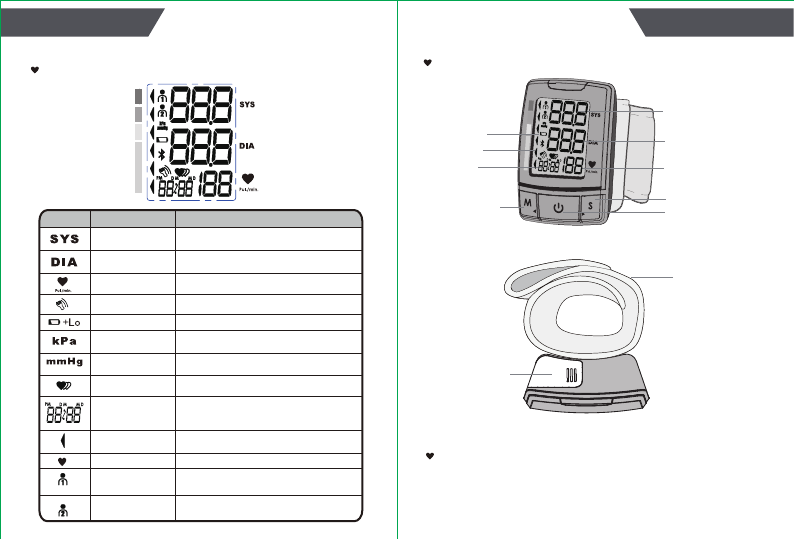
SYSTOLIC
DIASTOLIC
MEM BUTTON
SET BUTTON
START/STOP BUTTON
PULSE RATE
Systolic
blood pressure High pressure result
Diastolic
blood pressure Low pressure result
Pulse Pulse/minute; heartbeats/minute
mmHg Measurement unit the blood pressure
(1mmHg=0.133kPa)
kPa Measurement unit of the blood pressure
(1kPa=7.5mmHg)
Current time
Shocking
remainding Shocking will result in inaccurate
Irregular heartbeat detectionIrregular heartbeat
Low battery Batteries are low and need to be replaced
Grade The grade of the blood pressure
LCD Display Signal
SYMBOL DESCRIPTION EXPLANATION
Month/Day/Year,Hour/Minute
Heartbeat Heartbeat detection during the measurement
CUFF
(Type BF applied part)
Monitor Components
Component List:
1. PCBA;
2. Air Pipe;
3. Pump;
4. Valve;
5. Cuff.
List
1) Blood Pressure Monitor TMB-1580-BT
2) 2×AAA batteries
3) User manual
LCD DISPLAY
GRADE
TIME
User 1
User 2
Start measurement and save the
measuring results for user 1.
Start measurement and save the
measuring results for user 2.
BATTERY
COMPARTMENT
5
4
INTRODUCTION INTRODUCTION
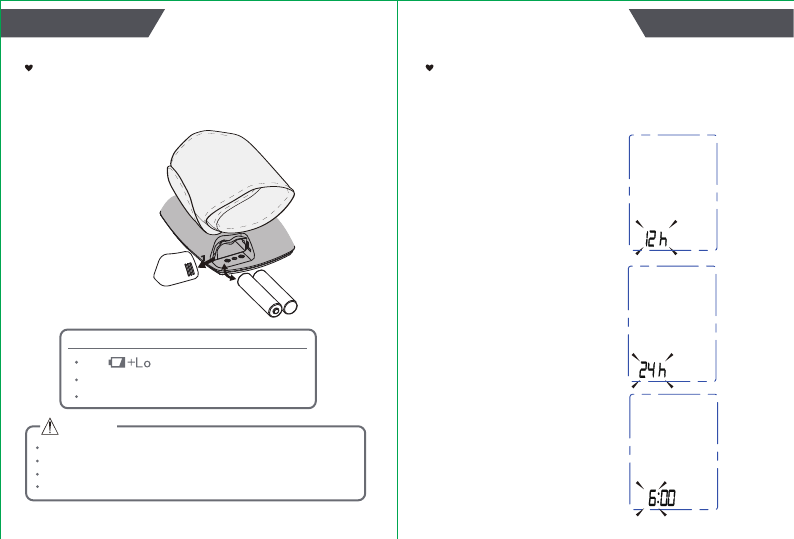
•.Slide off the battery cover.
•.Install the batteries by matching the correct polarity, as
shown below. Always use the correct battery type (2 x AAA batteries).
•.Replace the cover.
Installing and Replacing the Batteries
Remove batteries if the device is not likely to be used for some time.
The old batteries are harmful to the environment, do not dispose with other daily trash.
Remove the old batteries from the device and follow your local recycling guidelines.
Replace the batteries whenever the below happen
The shows
The display dims
The display does not light up
Do not dispose of batteries in fire. Batteries may explode or leak.
Setting Date, Time and Measurement Unit
It is important to set the clock before using your blood pressure
monitor, so that a time stamp can be assigned to each record that is
stored in the memory.
(year :2014—2054,time format:24 H/12 H)
1.
2. Press the “M” button to change
the [TIME FORMAT] between
12 hours and 24 hours.
3.
When the monitor is off, hold pressing
“S” button for about 3 seconds to set
the time format.
CAUTION
When you get the right time format,
press “S” button to confirm your
selection and it will turn to the next
step.
7
6
BEFORE YOU START BEFORE YOU START
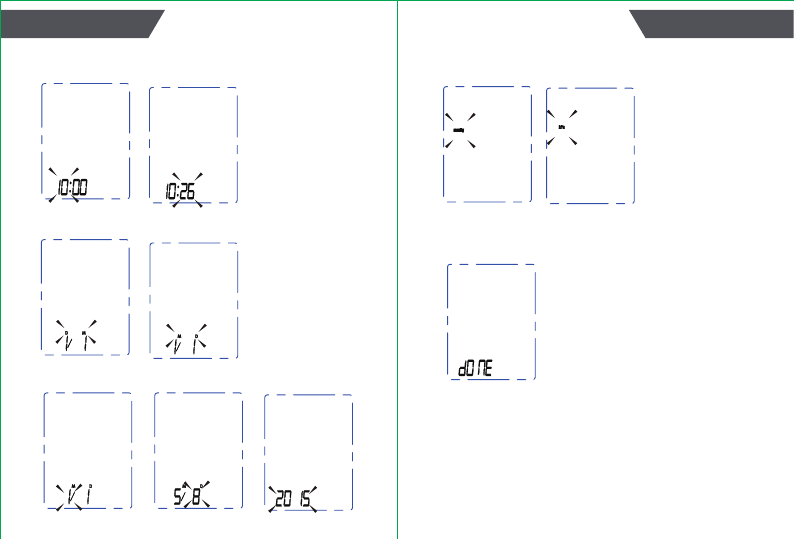
4.Repeat steps 2 and 3 to confirm [HOUR] and [MINUTE].
5.Then the monitor diverts to date format setting. Select the date format.
Repeat steps 2 and 3 to confirm the date format between DM and MD.
6.Repeat steps 2 and 3 to confirm the [MONTH] , [DAY] and [YEAR].
8.After confirming the meausrement unit, the LCD will
display “dOnE” and then turn off.
7.Repeat steps 2 and 3 to confirm the [MEASUREMENT UNIT].
9
8
BEFORE YOU START BEFORE YOU START
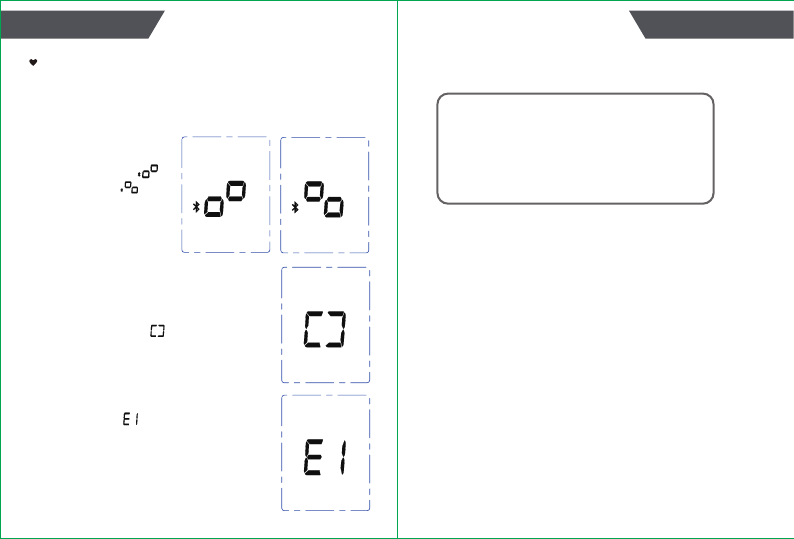
Pair-up the Blood Pressure Monitor with Your
Device
1 .Turn on Bluetooth and the app. Make sure both are ON when pair-up is
proceeding.
2 .When the monitor is OFF,
press and hold START/STOP
button about 3 seconds to start
pair-up. The symbol
and the symbol will be
shown on the LCD
alternatively, indicating
pair-up is proceeding.
If SUCCEED, symbol will
be shown on the LCD.
If FAIL, symbol will be
shown on the LCD.
4 .The monitor will shut off automatically
after Pair-up process is complete.
Bluetooth Module No.: AW2540MV1
RF Frequency Range:
Output Power Range:
Supply Voltage:
Transmitting Distance: 10 meters
2402 MHz to 2480 MHz
-1 dBm
2 V to 3.6V
3. Then please select the user ID you want to
connect with your smartphone on the app to
continute the pair-up.
11
10
BEFORE YOU START BEFORE YOU START
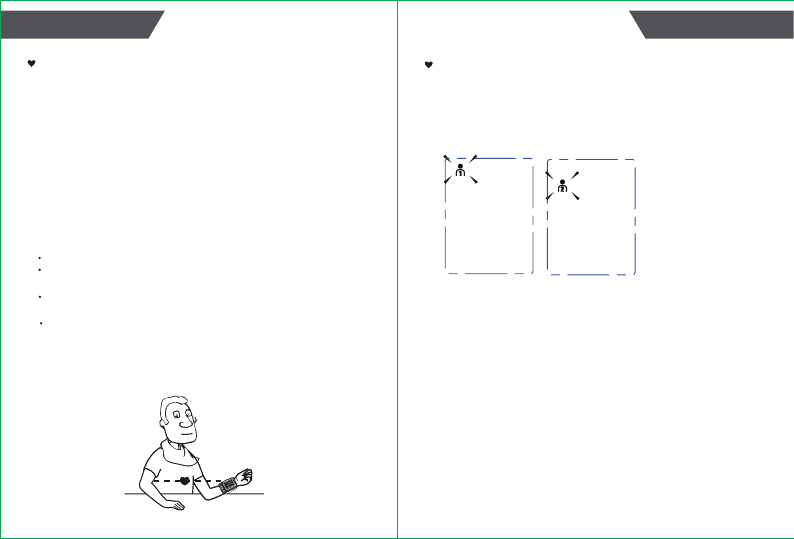
Tie the Cuff Select the User ID
1.When the blood pressure monitor is off, press and hold the MEM button
until the user ID blinks. Then press “M” button to change the user ID
between user 1 and user 2. Press “S” button to confirm your selection.
Before you start the measurement, please select the desired user ID first.
2. After confirming the user ID, the LCD will turn off. Then you can start
your measurement now.
1.Remove all accessories (watch, bracelet, etc) from your wrist. If your
physician has diagnosed you with poor circulation in your wrist, use the
other one.
2.Roll or push up your sleeve to expose the skin.
3.Apply the cuff to your wrist with your palm facing up.
4. Position the edge of the cuff about 1-1.5cm.
5. Fasten the wrist cuff around your wrist, leaving no extra room between the cuff
and your skin. If the cuff is too loose, the measurement will not be accurate.
Rest for 5 minutes before measuring.
Wait at least 3 minutes between measurements. This allows your blood
circulation to recover.
For a meaningful comparison, try to measure under similar conditions. For
example, take daily measurements at approximately the same time, on the same
wrist, or as directed by a physician.
Sit comfortably with your tested wrist resting on a flat surface.
Patients with Hypertension:
The middle of the cuff should be at the level of the right atrium of the heart;
Before starting measurement, please sit comfortably with legs uncrossed,
feet flat on the floor, back and wrist supported.
6.
7.
The patient must relax as much as possible and do not talk during the
measurement procedure.
13
12
MEASUREMENT MEASUREMENT
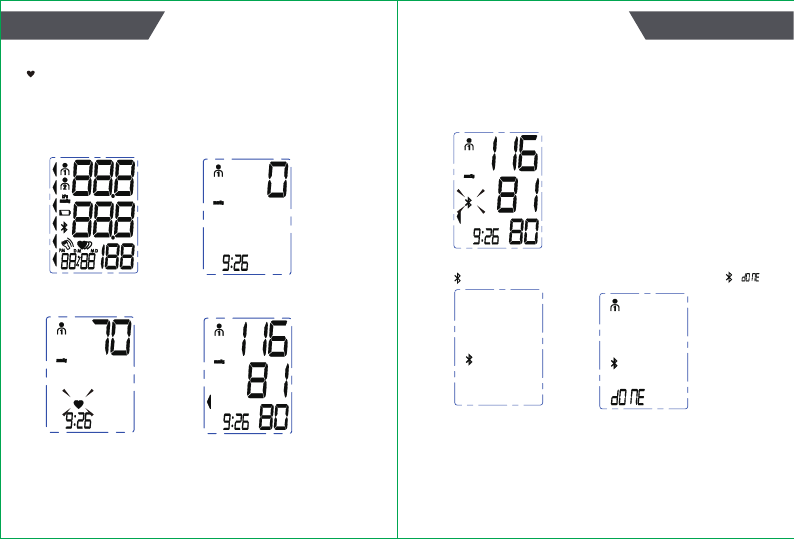
1.When the monitor is off, press “START/STOP” button to turn on the monitor,
and it will finish the whole measurement. (Take User 1 for example.)
Adjust to zero.
LCD display
Inflating and measuring. Display and save the
result.
Start the Measurement
3.
2.
Press “START/STOP” button to power off, otherwise it will turn off
within 1 minute.
This device will proceed to data transmission after measurement.
The Bluetooth symbol blinks on the LCD indicates data is transmitting.
If the data transmission fails,
lights all the time.
Tips: Maximum 60 records are both for User 1 and User 2.
If the data transmission succeeds,
the LCD will display “User ID+ + ”.
15
14
MEASUREMENT DATA MANAGEMENT
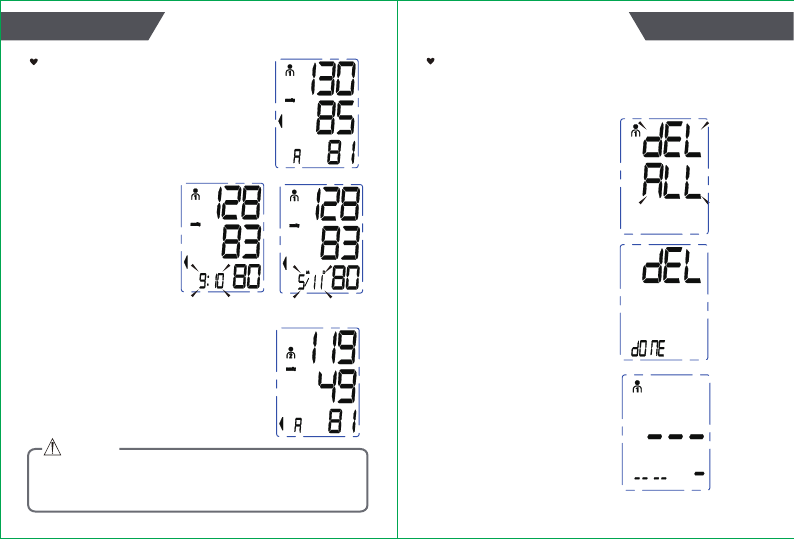
1.
2.Press “S” to confirm
deleting , the LCD displays
“ dEL dOnE” and the monitor
will turn off.
If you did not get the correct measurement, you can delete all
results by following steps below . (Take User 1 for example.)
Delete the Records
3.If there is no record. the
right display will show.
In the memory mode, hold
pressing “M” button for
3 seconds, the flash display
“User ID+ dEL All” will show.
The most recent record (1) is shown first. Each new measurement
is assigned to the first (1) record. All other records are pushed back
one digit (e.g., 2 becomes 3, and so on), and the last record (60) is
dropped from the list.
CAUTION
3. If you want to check the other user’s
measurement records, please press
“START/STOP” button to turn off the blood
pressure monitor. Then press and hold “M”
button to enter the selecting user mode, press
“M” again to change the user, when the desired
user ID blinks, press “S” button to confirm. Then
press “M” button to check the records of the
selected user.
Recall the Records
1.
2.
The date and time will
display alternately.
When the monitor is off, press “M” button to
show the average value of the latest three
measurement records. (Take User 1 for
example.)
Press “M” button or “S”
button to get the
record you want.
The corresponding
time is 9:10.
The corresponding
date is May 11 .
th
Note: To exit out of delete
mode without deleting any
records, press START/STOP
button before pressing “S” to
confirm any delete commands.
17
16
DATA MANAGEMENT DATA MANAGEMENT
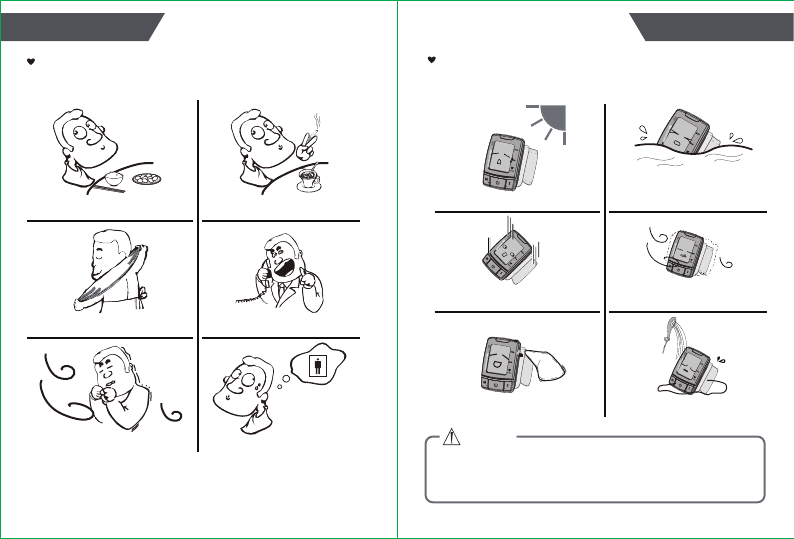
Maintenance
In order to get the best performance, please follow the
instructions below.
Put in a dry place and avoid the sunshine
Avoid intense shaking
and collisions
Using wet cloths to remove dirt
Avoid touching water,
clean it with a dry cloth in case.
Avoid dusty and unstable-
temperature environment
Avoid washing the cuff
Tips for Measurement
Wait at least 1 hour
after dinner or drinking
Wait at least 20 minutes
after taking a bath
In a very cold environment
Immediate measurement
after tea, coffee, smoking
When talking or moving your fingers
When you want to discharge urine CAUTION
• If you have any problems with this device, such as setting up, maintaining or using,
please contact the SERVICE PERSONNEL of TRANSTEK. Don’t open or repair the
device by yourself.
• Please report to TRANSTEK if any unexpected operation or events occur.
Measurements may be inaccurate if taken in the following
circumstances.
19
18
INFORMATION FOR USERINFORMATION FOR USER
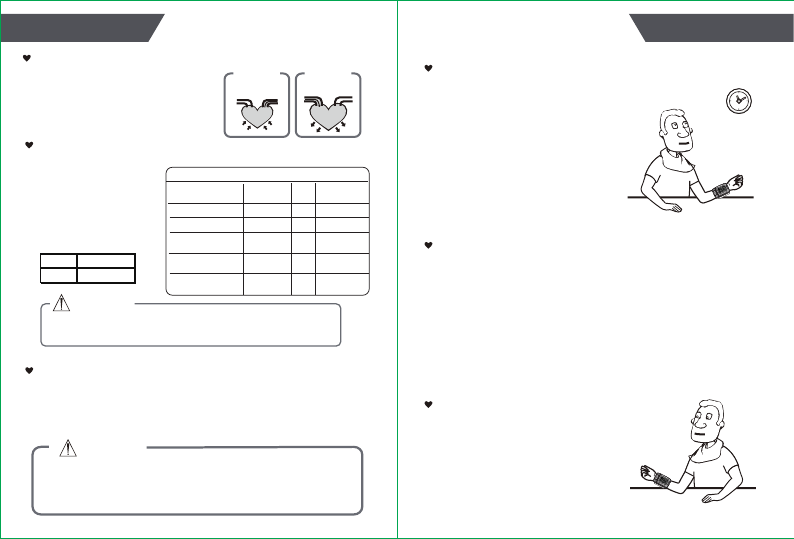
Why does my blood pressure
fluctuate throughout the
day?
What are systolic pressure and diastolic pressure?
What is the standard blood pressure classification?
press
artery vein
blood discharging
Systolic
relax
blood entering
Diastolic
CAUTION
Irregular Heartbeat Detector
The appearance of the IHB icon indicates that a pulse irregularity consistent with
an irregular heartbeat was detected during measurement. Usually this is NOT a
cause for concern. However, if the symbol appears often, we recommend you
seek medical advice. Please note that the device does not replace a cardiac
examination, but serves to detect pulse irregularities at an early stage.
An irregular heartbeat is detected when a heartbeat rhythm varies while the unit is
measuring the systolic and diastolic blood pressure.During each measurement,
this equipment records the heartbeat intervals and works out the standard deviation.
If the calculated value is larger than or equal to 15,the irregular heartbeat symbol
appears on the symbol when the measurement results are displayed.
1. Individual blood pressure varies
multiple times everyday. It is also
affected by the way you tie your cuff
and your measurement position, so
please take the measurement under
the same conditions.
2.If the person takes medicine, the
pressure will vary more.
3.Wait at least 3 minutes for
another measurement.
Why do I get a different
blood pressure at home
compared to the hospital?
The blood pressure is different
even throughout the day due to
weather, emotion, exercise etc, Also,
there is the “white coat” effect, which
means blood pressure usually
increases in clinical settings.
What you need to pay
attention to when you measure
your blood pressure at home:
If the cuff is tied properly.
If the cuff is too tight or too
loose.
If the cuff is tied on the wrist.
If you feel anxious.
Taking 2-3 deep breaths before
beginning will be better for
measuring.
Advice: Relax yourself for 4-5
minutes until you calm down.
Is the result the same if
measuring on the right
wrist?
It is ok for both wrists, but there will
be some different results for different
people. We suggest you measure the
same wrist every time.
When ventricles contract and pump blood
out of the heart, blood pressure reaches its
maximum value, the highest pressure in the
cycle is known as systolic pressure. When
the heart relaxes between heartbeats, the
lowest blood pressure is diastolic pressure.
The chart on the right is the
standard blood pressure
classification published by
American Heart Association
(AHA).
Only a physician can tell your normal BP range. Please contact a physician if your
measuring result falls out of the range. Please note that only a physician can tell
whether your blood pressure value has reached a dangerous point.
CAUTION
AHA Home Guideline for
Upper Limit of Normal BP
SYS 135 mm Hg
DIA 85 mm Hg
Blood Pressure Category
Normal
Prehypertension
High Blood Pressure
(Hypertension) Stage 1
High Blood Pressure
(Hypertension) Stage 2
Hypertensive Crisis
(Emergency care needed)
Systolic
mmHg (upper#)
Diastolic
mmHg (lower#)
less than 120
120-139
140-159
160 or higher
Higher than 180
and
or
or
or
or
less than 80
80-89
90-99
100 or higher
Higher than 110
This chart reflects blood pressure categories defined by American Heart Association.
21
20
ABOUT BLOOD PRESSUREABOUT BLOOD PRESSURE
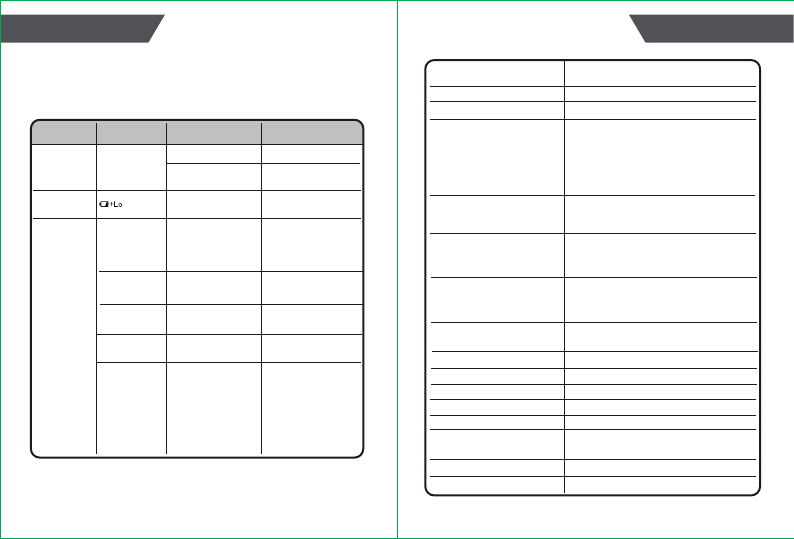
Power supply Battery powered mode:
2*AAA batteries (3V DC)
Display mode Digital LCD V.A.35mm×46mm
Measurement mode Oscillographic testing mode
Measurement range
Accuracy
Normal working condition
Storage & transportation
condition
Measurement perimeter
of the wrist About 13.5cm-21.5cm
Net Weight Approx.120g(Excluding the dry cells)
External dimensions
Attachment
Approx.64mmx90mmx57mm (Exclude the cuff)
2*AAA batteries,user manual
Mode of operation Continuous operation
Degree of protection Type BF applied part
Protection against
ingress of water IPX0
Software version
Device classification
V01
Internally Powered ME Equipment
WARNING: No modification of this equipment is allowed.
This section includes a list of error messages and frequently
asked questions for problems you may encounter with your wrist
blood pressure monitor. If the products not operating as you
think it should, check here before arranging for servicing.
PROBLEM SYMPTOM CHECK THIS REMEDY
No power
Low
batteries
Error
massage
Display is dim or
will not light up.
Batteries are exhausted. Replace with new batteries
Insert the batteries
correctly
Replace with new batteries
Batteries are inserted
incorrectly.
Show on
the display Batteries are low.
Err 1 shows The cuff is too loose. Refasten the cuff and then
measure again.
Err 2 shows The cuff is very tight Refasten the cuff and then
measure again.
Err 3 shows The pressure of the
cuff is excess.
Relax for a moment
and then measure again.
EExx,shows on
the display.
A calibration error
occurred.
Retake the measurement.
If the problem persists,
contact the retailer or our
customer service
department for further
assistance.Refer to the
warranty for contact
information and return
instructions.
Pressure:
5℃-40℃within±0.4kPa(3mmHg)
pulse value:±5%
Temperature:5℃ to 40℃
Relative humidity: ≤85%RH
Atmospheric pressure: 86kPa to 106kPa
Temperature:-20℃ to 60℃
Relative humidity: 10%RH to 93%RH
Atmospheric pressure: 50kPa to 106kPa
Rated cuff pressure:
0kPa - 40kPa (0mmHg~300mmHg)
Measurement pressure: 5.3kPa-30.7kPa
(40mmHg-230mmHg)
pulse value: (40-199) beat/minute
Data communication
is failed.
Check if the Bluetooth
function of the smartphone
is on or it is during the
range of distance
E 1 shows
23
22
SPECIFICATIONSTROUBLESHOOTING

Contact Information
For more information about our products, please visit www.transtek.cn.you
can get customer service, usual problems and customer download, transtek
will serve you anytime.
Manufactured by:
Company:
Address:
Guangdong Transtek Medical Electronics Co., Ltd.
Zone A, No.105 ,Dongli Road, Torch Development District,
Zhongshan,528437,Guangdong,China
Guangdong Transtek Medical Electronics Co., Ltd.
FCC Statement
FCC ID: OU9TMB1580-B
FCC Statement
This equipment has been tested and found to comply with the limits for a Class B
digital device, pursuant to part 15 of the FCC rules. These limits are designed to
provide reasonable protection against harmful interference in a residential
installation. This equipment generates, uses, and can radiate radio frequency
energy and, if not installed and used in accordance with the instructions,
may cause harmful interference to radio communications. However, there is no
guarantee that interference will not occur in a particular installation.
If this equipment does cause harmful interference to radio or television reception,
which can be
determined by turning the equipment off and on, the user is encouraged to try to
correct the
interference by one or more of the following measures:
• Reorient or relocate the receiving antenna.
• Increase the separation between the equipment and receiver.
• Connect the equipment into an outlet on a circuit different from that to which the
receiver
is connected.
• Consult the dealer or an experienced radio/TV technician for help.
To assure continued compliance, any changes or modifications not expressly
approved by the
party responsible for compliance could void the user’s authority to operate this
equipment.
Radiation Exposure Statement
This equipment complies with FCC radiation exposure limits set forth for an
uncontrolled
environment and it also complies with Part 15 of FCC RF Rules.
CAUTION:
To comply with the limits of the Class B digital device, pursuant to Part 15 of the
FCC Rules, this device is comply with Class B limits. All peripherals must be
shielded and grounded. Operation with non-certified peripherals or non-shielded
cables may results in interference to radio or reception.
MODIFICATION:
Any changes or modifications not expressly approved by the grantee of this device
could void the user’s authority to operate the device.
Label Statement:
This device complies with part 15 of the FCC Rules. Operation is subject to the
following two conditions: (1) This device may not cause harmful interference, and
(2) this device must accept any interference received, including interference that
may cause undesired operation.
25
24
CONTACT INFORMATION FCC STATEMENT
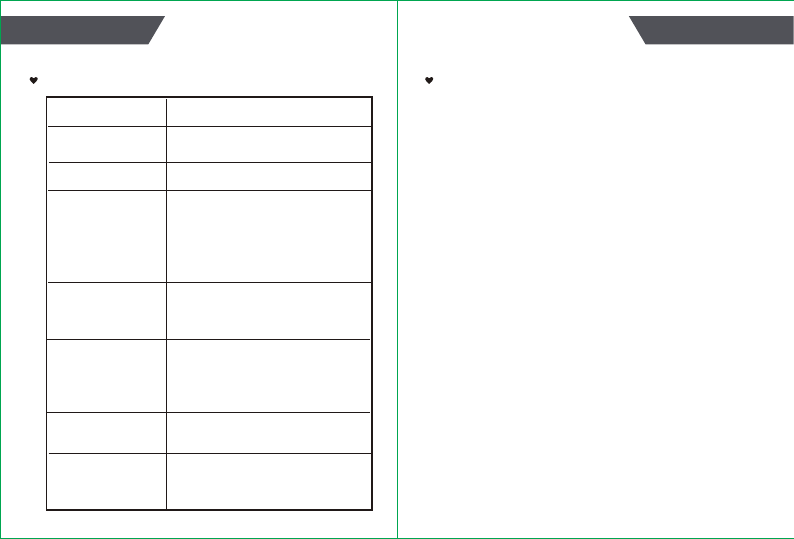
EMC Guidance
Complied Standards List
1) This equipment needs to be installed and put into service
in accordance with the information provided in the user
manual;
2) Wireless communications equipment such as wireless
home network devices, mobile phones, cordless telephones
and their base stations, walkie-talkies can affect this
equipment and should be kept at least a distance d=3,3m
away from the equipment.
(Note: As indicated in Table 6 of IEC 60601-1-2:2007 for ME
EQUIPMENT, a typical cell phone with a maximum output
power of 2 W yields d=3, 3m at an IMMUNITY LEVEL of
3V/m)
Risk management
Labeling
User manual
General Requirements
for Safety
Electromagnetic
compatibility
Performance
requirements and
Clinical investigation
Software life-cycle
processes
ISO/EN 14971:2012 Medical devices — Application of
risk management to medical devices
ISO/EN 15223-1:2012 Medical devices. Symbols to
be used with medical device labels, labelling and
information to be supplied. General requirements
EN 1041: 2008 Medical equipment manufacturers to
provide information
IEC 60601-1: 2005+A1:2012 Medical electrical
equipment - Part 1: General requirements for basic safety
and essential performance
IEC 60601-1-11 Medical electrical equipment - Part
1-11: General requirements for basic safety and essential
performance - Collateral standard: Requirements for
medical electrical equipment and medical electrical
systems used in the home healthcare environment
IEC/EN 60601-1-2:2007 Medical electrical equipment -
Part 1-2: General requirements for basic safety and
essential performance - Collateral
standard:Electromagnetic compatibility - Requirements
and tests
IEC 80601-2-30:2009 Medical electrical equipment-
Part 2-30: Particular requirements for the basic safety
and essential performance of automated non-invasive
sphygmomanometers
IEC/EN 62304:2006+AC: 2008 Medical device
software - Software life cycle processes
Usability
IEC 62366 Medical devices - Application of usability
engineering to medical devices (IEC 62366:2007)
IEC 60601-1-6 Medical electrical equipment - Part 1
-6 : General requirements for basic safety and
essential performance - collateral standard : Usability
ANSI/AAMI SP10:2002/A2: 2008 Manual, electronic,
or automated sphygmomanometers
26 27
EMC GUIDANCECOMPLIED STANDARDS LIST